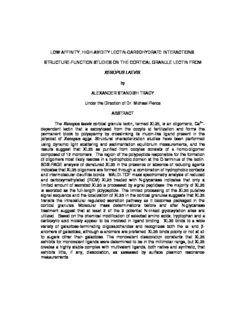
low affinity, high-avidity lectin-carbohydrate interactions PDF
Preview low affinity, high-avidity lectin-carbohydrate interactions
LOW AFFINITY, HIGH-AVIDITY LECTIN-CARBOHYDRATE INTERACTIONS: STRUCTURE-FUNCTION STUDIES ON THE CORTICAL GRANULE LECTIN FROM XENOPUS LAEVIS. by ALEXANDER STANDISH TRACY Under the Direction of Dr. Michael Pierce ABSTRACT The Xenopus laevis cortical granule lectin, termed XL35, is an oligomeric, Ca2+- dependent lectin that is exocytosed from the oocyte at fertilization and forms the permanent block to polyspermy by crosslinking its mucin-like ligand present in the jellycoat of Xenopus eggs. Structural characterization studies have been performed using dynamic light scattering and sedimentation equilibrium measurements, and the results suggest that XL35 as purified from oocytes consists of a homo-oligomer composed of 12 monomers. The region of the polypeptide responsible for the formation of oligomers most likely resides in a hydrophobic domain at the C-terminus of the lectin. SDS-PAGE analysis of denatured XL35 in the presence or absence of reducing agents indicates that XL35 oligomers are formed through a combination of hydrophobic contacts and intermolecular disulfide bonds. MALDI-TOF mass spectrometry analysis of reduced and carboxymethylated (RCM) XL35 treated with N-glycanase indicates that only a limited amount of secreted XL35 is processed by signal peptidase: the majority of XL35 is secreted as the full-length polypeptide. The limited processing of the XL35 putative signal sequence and the localization of XL35 in the cortical granules suggests that XL35 transits the intracellular regulated secretion pathway as it becomes packaged in the cortical granules. Molecular mass determinations before and after N-glycanase treatment suggest that at least 2 of the 3 potential N-linked glycosylation sites are utilized. Based on the chemical modification of selected amino acids, tryptophan and a carboxylic acid moiety appear to be involved in ligand binding. XL35 binds to a wide variety of galactose-terminating oligosaccharides and recognizes both the a - and b - anomers of galactose, although a -anomers are preferred. XL35 binds poorly or not at all to sugars other than galactose. The monovalent dissociation constants that XL35 exhibits for monovalent ligands were determined to be in the millimolar range, but XL35 creates a highly stable complex with multivalent ligands, both native and synthetic, that exhibits little, if any, dissociation, as assessed by surface plasmon resonance measurements. The ability of XL35 to efficiently form the block to polyspermy is intimately linked to its intrinsically low monovalent affinity along with the high-avidity multivalent interactions that are a result of its oligomeric structure. XL35 has also shown Ca2+-dependent binding to Cryptococcus neoformans and Candida albicans, and its localization to the epidermis in the Xenopus tailbud-stage embryos suggests that it may have a role in innate immunity. INDEX WORDS: Ca2+-dependent lectin, fertilization, Xenopus laevis, multivalent interaction, inhibition assay, surface plasmon resonance LOW AFFINITY, HIGH-AVIDITY LECTIN-CARBOHYDRATE INTERACTIONS: STRUCTURE-FUNCTION STUDIES ON THE CORTICAL GRANULE LECTIN FROM XENOPUS LAEVIS By ALEXANDER STANDISH TRACY B.S., The College of William and Mary, 1989 M.S., George Mason University, 1997 A Dissertation Submitted to the Graduate Faculty of The University of Georgia in Partial Fulfillment of the Requirements for the Degree DOCTOR OF PHILOSOPHY ATHENS, GEORGIA 2002 ©2002 Alexander Standish Tracy All Rights Reserved LOW AFFINITY, HIGH-AVIDITY LECTIN-CARBOHYDRATE INTERACTIONS: STRUCTURE-FUNCTION STUDIES ON THE CORTICAL GRANULE LECTIN FROM XENOPUS LAEVIS by ALEXANDER STANDISH TRACY Approved: Major Professor: Michael Pierce Committee: Kojo Mensa-Wilmot James Prestegard J. David Puett Robert Woods Electronic Version Approved: Gordhan L. Patel Dean of the Graduate School The University of Georgia May 2002 DEDICATION To my wife, who has always encouraged me as a scientist and has helped me to grow as a husband and father. To our children, who help us to rediscover the world that we thought we knew so well. iv ACKNOWLEDGMENTS I would like to thank Dr. Michael Pierce for many years of support and encouragment: he has acted both as a mentor and friend and I am very grateful for all of his contributions to my training. In addition, I would also like to thank my committee members for their insight and guidance as my project developed. Thanks also to the members of the Pierce lab who have helped me in many ways during graduate career: Trisha Sheahan, Gerardo Alvarez-Manilla, Maria Kamar, Intaek Lee, and Jin-Kyu Lee. v TABLE OF CONTENTS Page ACKNOWLEDGMENTS......................................................................................................v LIST OF TABLES..............................................................................................................viii LIST OF FIGURES..............................................................................................................ix LIST OF ABBREVIATIONS...............................................................................................xii CHAPTER 1 – LITERATURE REVIEW..............................................................................1 Introduction......................................................................................................................1 Mannose Binding Protein................................................................................................5 XL35...............................................................................................................................13 Jellycoat Protein (JCP)..................................................................................................21 Homologues of XL35.....................................................................................................27 CHAPTER 2 – MATERIALS AND METHODS.................................................................30 Purification of XL35........................................................................................................30 SDS-PAGE Analyses.....................................................................................................30 Dynamic Light Scatttering..............................................................................................31 Sedimentation Equilibrium Analysis..............................................................................31 MALDI-TOF....................................................................................................................32 Chemical Modification Studies......................................................................................32 Preparation of JCP-Alkaline Phosphatase Conjugate - Thiolation of JCP...................33 Preparation of JCP-Alkaline Phosphatase Conjugate - Derivatization of BAP ............33 Biotinylation of XL35......................................................................................................34 vi ELISA Inhibition Assay..................................................................................................34 Capture Inhibition Assay................................................................................................35 Saturation Binding Assays.............................................................................................35 Surface Plasmon Resonance (SPR) Analyses.............................................................36 Characterization of the Glycopolymers and JCP..........................................................37 Phenol-Sulfuric Assay....................................................................................................37 CHAPTER 3 - RESULTS..................................................................................................39 Structural Studies – Mechanism of XL35 Oligomerization............................................39 Structural Studies – Size of Oligomer as Determined by Sedimentation Equilibrium..42 Structural Studies – Size of Oligomer as Determined by Light Scattering...................46 Studies on Monomer - Signal Sequence and Molecular Weight of XL35 Monomer....48 Ligand Binding Properties of XL35 - Residues involved in ligand binding...................54 Ligand Binding – ELISA Assay Development and Characterization............................56 CHAPTER 4 - DISCUSSION............................................................................................80 Structure and Organization of XL35..............................................................................80 XL35 Ligand Binding Properties....................................................................................85 REFERENCES..................................................................................................................94 vii LIST OF TABLES TABLE 3-1: DYNAMIC LIGHT SCATTERING RESULTS FOR XL35.............................46 TABLE 3-2: INHIBITION DATA FOR MONOVALENT COMPOUNDS............................61 TABLE 3-3: INHIBITION DATA FOR MULTIVALENT LIGANDS....................................64 TABLE 3-4 : DIFFERENCES IN APPARENT K AS A FUNCTION OF ASSOCIATION OFF TIME...........................................................................................................................74 viii
Description: